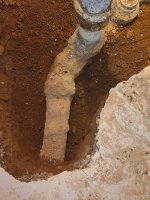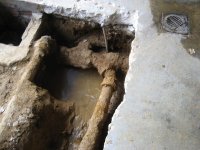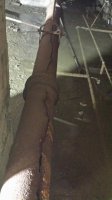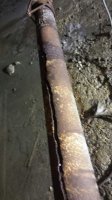SIWEL56AA
New Member
Hello all, any help would be greatly appreciated.
I have come across a situation while attempting to replace my cast iron sewer house trap with PVC. The house trap is constantly backing up so after having roto-rooter come out and inspect, it has been determined that the house trap is closing due to corrosion... the hole is a little bigger than an old sliver dollar. The house is about 100 year old.
While digging out the trap I found the cast iron pipe encased in concrete along with the hubs on both end of the trap. My initial thought was to cut the cast iron pipe on the house side and then cut a piece on the sewer side and tie them in with 4" heav-duty stainless steel no hub couplings, without having to replace the entire pipe on both sides of the trap.
My question: is there some type of chemical that can dissolve the concrete from around the hub and or a way to remove the concrete from the hub/ pipe?
Pic is attached
Thanks for any advice on this matter....
Siwel
I have come across a situation while attempting to replace my cast iron sewer house trap with PVC. The house trap is constantly backing up so after having roto-rooter come out and inspect, it has been determined that the house trap is closing due to corrosion... the hole is a little bigger than an old sliver dollar. The house is about 100 year old.
While digging out the trap I found the cast iron pipe encased in concrete along with the hubs on both end of the trap. My initial thought was to cut the cast iron pipe on the house side and then cut a piece on the sewer side and tie them in with 4" heav-duty stainless steel no hub couplings, without having to replace the entire pipe on both sides of the trap.
My question: is there some type of chemical that can dissolve the concrete from around the hub and or a way to remove the concrete from the hub/ pipe?
Pic is attached
Thanks for any advice on this matter....
Siwel





